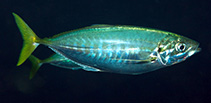http://www.fishbase.org/Summary/speciesSummary.php?genusname=Atule&speciesname=mate ---> http://52.67.158.155/Summary/speciesSummary.php?genusname=Atule&speciesname=mate
http://52.67.158.155/Summary/speciesSummary.php?genusname=Atule&speciesname=mate ---> https://fishbase.net.br/Summary/speciesSummary.php?genusname=Atule&speciesname=mate
https://fishbase.net.br/Summary/speciesSummary.php?genusname=Atule&speciesname=mate ---> https://fishbase.net.br/summary/Atule-mate.html
Atule mate, Yellowtail scad : fisheries, gamefish

You can
sponsor
this page
Common name (e.g. trout)
Genus + Species (e.g. Gadus morhua)
-

-
About this page
-
Languages
-
User feedbacks
-
Citation
-
Uploads
-
Related species
-


 Yellowtail scad
Add your observation in
Fish Watcher
Upload your
photos
and
videos
Yellowtail scad
Add your observation in
Fish Watcher
Upload your
photos
and
videos
Pictures
|
Videos |
Google image
 Atule mate
Atule mate
Picture by
Malaer, P.
Teleostei (teleosts) >
Carangiformes
(Jacks) >
Carangidae
(Jacks and pompanos) > Caranginae
Etymology: More on author:
Cuvier
.
Environment: milieu / climate zone / depth range / distribution range
Ecology
Marine; brackish; reef-associated; depth range 1 - 80 m (Ref.
58302
). Tropical; 35°N - 35°S, 24°E - 135°W
Indo-Pacific: Red Sea and the east coast of Africa to the Hawaiian Islands and Samoa, north to Japan (Ref.
559
), south to the Arafura Sea (Ref.
9819
) and northern Australia.
Length at first maturity / Size / Weight / Age
Maturity: L
m
?
, range 17 - ? cm
Max length : 30.0 cm TL male/unsexed; (Ref.
30573
); common length : 26.0 cm TL male/unsexed; (Ref.
30573
)
Dorsal
spines
(total): 9;
Dorsal
soft rays
(total): 22-25;
Anal
spines
: 3;
Anal
soft rays
: 18 - 21. This species is distinguished by the following characters: adipose eyelid well developed and completely covering eye except for a vertical slit centred on pupil; shoulder girdle (cleithrum) margin smooth, without papillae; terminal dorsal and anal rays finlet-like in adults, about twice length of adjacent rays and a little more separated but joined by interradial membrane; lateral line gently arched anteriorly, with junction of curved and straight parts below vertical from sixth to eighth soft rays of second dorsal fin; scales in curved part of lateral line 39 to 57; straight part with 0 to 10 scales and 36 to 49 scutes; a black spot, slightly smaller than eye, on upper margin of opercle and adjacent area of shoulder; dorsal and caudal fins dusky greenish yellow; anal fin pale yellow (Ref.
9894
).
Adults inhabit mangroves and coastal bays in pelagic waters (Ref.
58302
). They form schools to about 50 m in inshore waters (Ref.
9894
), or singly (Ref.
48635
). Are mainly diurnal. They feed mainly on crustaceans and planktonic invertebrates such as copepods, including cephalopods (Ref.
5213
,
90102
). They swim fast in midwater in pursuit of zooplankton (Ref.
48635
).
Paxton, J.R., D.F. Hoese, G.R. Allen and J.E. Hanley
, 1989. Pisces. Petromyzontidae to Carangidae. Zoological Catalogue of Australia, Vol. 7. Australian Government Publishing Service, Canberra, 665 p. (Ref.
7300
)
IUCN Red List Status (Ref.
130435
)
Least Concern (LC)
; Date assessed:
06 March 2015
CITES
Not Evaluated
Not Evaluated
Threat to humans
Harmless
Human uses
Fisheries: minor commercial; gamefish: yes
FAO - Fisheries:
landings
; Publication:
search
|
FishSource
|
Sea Around Us
More information
Countries
FAO areas
Ecosystems
Occurrences
Introductions
Stocks
Ecology
Diet
Food items
Food consumption
Ration
Common names
Synonyms
Metabolism
Predators
Ecotoxicology
Reproduction
Maturity
Spawning
Spawning aggregation
Fecundity
Eggs
Egg development
Age/Size
Growth
Length-weight
Length-length
Length-frequencies
Morphometrics
Morphology
Larvae
Larval dynamics
Recruitment
Abundance
BRUVS
References
Aquaculture
Aquaculture profile
Strains
Genetics
Electrophoreses
Heritability
Diseases
Processing
Nutrients
Mass conversion
Collaborators
Pictures
Stamps, Coins Misc.
Sounds
Ciguatera
Speed
Swim. type
Gill area
Otoliths
Brains
Vision
Tools
E-book
|
Field guide
|
Identification keys
|
Length-frequency wizard
|
Life-history tool
|
Point map
|
Classification Tree
|
Catch-MSY
|
Special reports
Check for Aquarium maintenance
|
Check for Species Fact Sheets
|
Check for Aquaculture Fact Sheets
Download XML
Summary page
|
Point data
|
Common names
|
Photos
Internet sources
AFORO (otoliths) |
Aquatic Commons
|
BHL
|
Cloffa
|
BOLDSystems
|
Websites from users
|
Check FishWatcher
|
CISTI
|
Catalog of Fishes
:
genus
,
species
|
DiscoverLife
|
ECOTOX
| FAO - Fisheries:
landings
; Publication:
search
|
Faunafri
| Fishipedia |
Fishtrace
| GenBank:
genome
,
nucleotide
|
GloBI
|
Google Books
|
Google Scholar
|
Google
| IGFA World Record |
MitoFish
|
National databases
|
Otolith Atlas of Taiwan Fishes
|
PubMed
|
Reef Life Survey
| Socotra Atlas |
Tree of Life
| Wikipedia:
Go
,
Search
| World Records Freshwater Fishing |
Zoological Record
Estimates based on models
Preferred temperature (Ref.
123201
): 23.8 - 29.1, mean 28 °C (based on 2048 cells).
Phylogenetic diversity index (Ref.
82804
): PD
50
= 1.0000 [Uniqueness, from 0.5 = low to 2.0 = high].
Bayesian length-weight: a=0.01349 (0.01197 - 0.01520), b=2.96 (2.93 - 2.99), in cm total length, based on LWR estimates for this species (Ref.
93245
).
Trophic level (Ref.
69278
): 4.2 ±0.5 se; based on diet studies.
Resilience (Ref.
120179
): High, minimum population doubling time less than 15 months (K=0.58-1.00; Fec=63,000-161,000 (batch fecundity)).
Fishing Vulnerability (Ref.
59153
): Low vulnerability (18 of 100).
Climate Vulnerability (Ref.
125649
): Moderate to high vulnerability (47 of 100).
Price category (Ref.
80766
):
Medium
.
Nutrients (Ref.
124155
): Calcium = 79.4 [45.4, 166.2] mg/100g; Iron = 1.04 [0.59, 1.83] mg/100g; Protein = 20 [19, 21] %; Omega3 = 0.193 [0.120, 0.326] g/100g; Selenium = 33.1 [17.7, 62.5] μg/100g; VitaminA = 87.6 [28.1, 279.3] μg/100g; Zinc = 1.17 [0.79, 1.61] mg/100g (wet weight); based on
nutrient studies.
Back to Search
Random Species
Back to Top
Accessed through:
Not available
FishBase mirror site :
Laguna, Philippines
Page last modified by :
mrius-barile
|